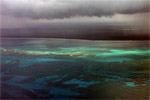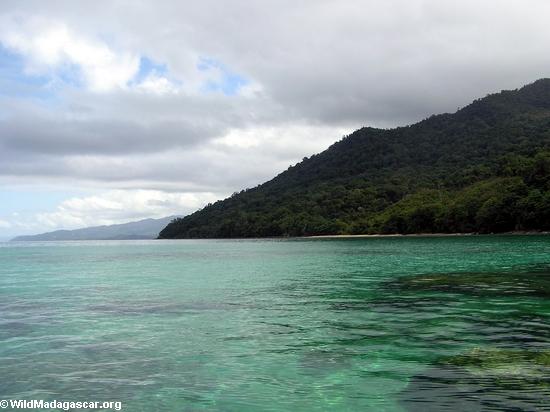Antongil Bay
Sediment carried by rivers draining deforested areas in Madagascar is smothering local coral reefs, increasing the incidence of disease and suppressing growth, report new studies published in the journals Biogeosciences and Marine Pollution Bulletin.
The first study looked specifically at coral communities in Antongil Bay, located in northeastern Madagascar, while the second included data from Western Madagascar. Antongil Bay is Madagascar’s largest bay and world-famous as nursing grounds for humpback whales.
The authors analyzed coral’s luminescent bands, which reveal the growth history of coral much like growth rings of a tree. They found that corals near rivers “showed clear signs of disease and distorted growth patterns”, according to study co-author Jens Zinke of the University of Western Australia’s Oceans Institute.
“Results from the study suggest that changes in land use – primarily the removal of forests – and Madagascar’s increased population density are the key drivers of long-term reef sedimentation trends,” Zinke added in a statement. “This is the first direct evidence that catchment activity in Madagascar through deforestation and land use practices affects near-shore reef ecosystems.”
Madagascar has suffered from widespread deforestation. Around Antongil Bay forests have been cleared for rice cultivation and cattle grazing. Remaining forests have been heavily impacted by illegal rosewood and ebony logging.
Zinke says the results underline the importance of holistic approaches to conservation.
“Just as importantly, these results reinforce the need to incorporate terrestrial land-use management in the design of coral reef protection networks in the region,” he said. “There is a dire need to combine efforts on terrestrial and marine conservation in unison to sustain Madagascar’s biodiversity.”
C.A. Grove at al (2012). Spatial linkages between coral proxies of terrestrial runoff across a large embayment in Madagascar, Biogeosciences, 9, 3063-3081, doi:10.5194/bg-9-3063-2012.
Joseph Maina et al (2012). Linking coral river runoff proxies with climate variability, hydrology and land-use in Madagascar catchments. Marine Pollution Bulletin, Available online 31 July 2012 http://dx.doi.org/10.1016/j.marpolbul.2012.06.027
Related articles
Gibson Guitar to pay $300,000 for violating Lacey Act with illegal timber imports from Madagascar
(08/06/2012) Gibson Guitar Company has avoided criminal prosecution under the Lacey Act — a law that aims to curb illegal logging abroad — by settling with the Department of Justice.
Scientists recommend marine protected areas for Madagascar
(02/27/2012) With the government of Madagascar planning to increase marine protected areas by one million hectares, a group of researchers have laid out flexible recommendations in a new study in the open access journal PLoS ONE. The researchers employed four different analyses in order to highlight a number of different conservation options, however the different analyses pointed to the need to protect certain areas with high biodiversity, including the Barren Islands’ reefs, the reefs of Juan de Nova, the Banc de Leven, and the shallow banks of the Cap Sainte Marie.
Healthy coral reefs produce clouds and precipitation

(03/03/2010) Twenty years of research has led Dr. Graham Jones of Australia’s Southern Cross University to discover a startling connection between coral reefs and coastal precipitation. According to Jones, a substance produced by thriving coral reefs seed clouds leading to precipitation in a long-standing natural process that is coming under threat due to climate change.
Marine protected areas boost fishing yields
(12/18/2006) A new study conducted on the reefs of Madagascar found that marine protected areas can benefit the fishing industry. The study, authored by Frances Humber, a scientist with conservation group Blue Ventures, found that implementing seasonal fishing closures for octopus boosted returns for fishermen when the closed areas were reopened to fishing after seven months. Octopus yields increased 13 times while the total weight of octopus caught jumped 25 times.
Massive coral bleaching in Madagascar
(10/06/2006) A new survey of reefs along Madagascar’s southwestern coast found massive damage from coral bleaching, including some reefs that lost up to 99 percent of their coral cover. But the survey team, led by the conservation groups Blue Ventures and the Wildlife conservation Society (WCS) and funded by conservation International (CI), also found some signs of hope. Scientists discovered several small reefs with corals that appeared to be resilient to rising sea temperatures and could ultimately be used to reseed damaged reefs. These resilient reefs may also provide valuable information about how to protect corals from future damage.
